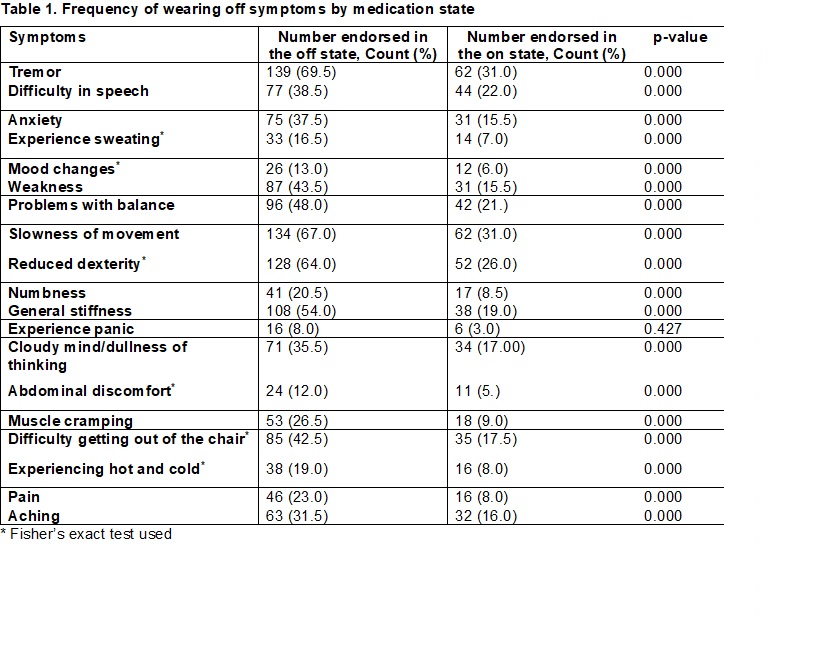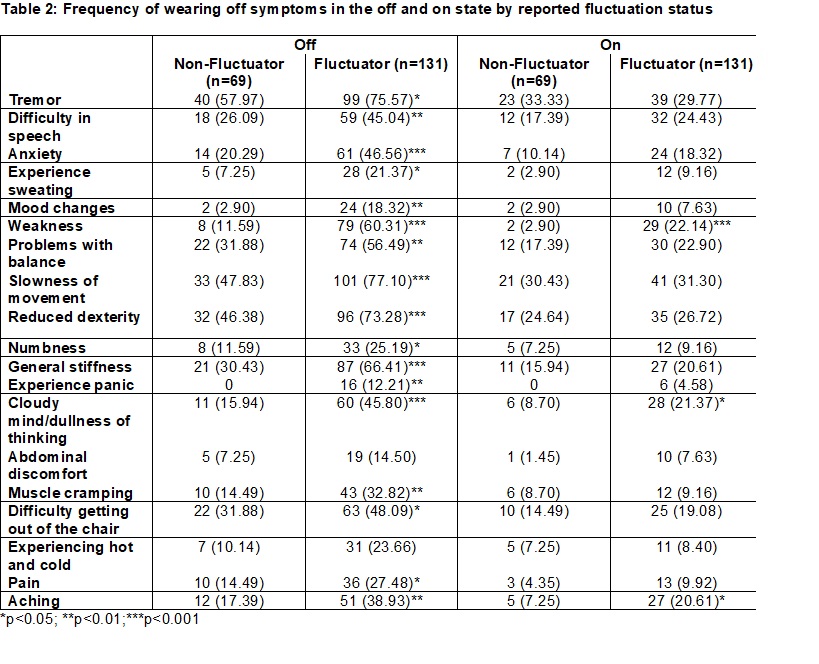Category: Parkinson's Disease: Non-Motor Symptoms
Objective: To determine if the frequency of wearing-off symptoms in Parkinson’s disease (PD) patients who report fluctuations differs from patients without fluctuations.
Background: Wearing-off, the recurrence of motor symptoms when the effect of dopaminergic treatment declines over a given dose, leads to an episodic worsening of motor and non-motor symptoms referred to as “fluctuations”. Wearing-off symptoms (WOS) occur in up to 40% of PD patients within 4-6 years of starting levodopa therapy [1,2]. Previous research has described the frequency of WOS; however, few studies have evaluated this frequency in a controlled “off” and “on” state or determined if symptom frequency differs by patient-reported fluctuation status [3].
Method: We conducted an on/off evaluation of motor and non-motor PD symptoms in 200 participants with a diagnosis of idiopathic PD. WOS were measured using the 19-item Wearing-Off Questionnaire. The frequency of reporting each of these 19 symptoms was determined in both medication “off” and “on” states. To determine how fluctuations impact these reports, participants with fluctuations were identified with the MDS-UPDRS IV. Chi-squared or Fisher’s exact tests were conducted to evaluate differences in reporting symptoms.
Results: The most common WOS were the same in the “off” state and the “on” state: tremor (off: 69.5%, on: 31.0%), slowness of movement (off: 67%, on: 31.0%), and reduced dexterity (off: 64%, on: 26.0%) [table1]. As expected, symptom endorsement was significantly more frequent in the “off” state than the “on” state for most symptoms, with the exception of the “experience panic” symptom (p=0.427). When stratifying participants by fluctuation status [table2], the most common “off” symptoms reported by fluctuators (n=131, 66%) were anxiety (75.6%), tremor (45.0%) and aching (46.6%), compared to non-fluctuators (n=69, 35%) who reported tremor (58.0%), slowness of movement (47.8%), and reduced dexterity (46.4%).
Conclusion: We determined that most patients experience tremor, slowness of movement, and reduced dexterity regardless of medication state. However, in the “off” state fluctuators were more likely to report anxiety, tremor, and aching. It is important to consider the effect of medication state and fluctuation status on these symptoms.
References: 1. Group PS. Levodopa and the progression of Parkinson’s disease. New England Journal of Medicine. 2004;351(24):2498-2508. 2. Stacy M. The wearing-off phenomenon and the use of questionnaires to facilitate its recognition in Parkinson’s disease. Journal of neural transmission. 2010;117(7):837-846. 3. Witjas T, Kaphan E, Azulay JP, et al. Nonmotor fluctuations in Parkinson’s disease: frequent and disabling. Neurology. 2002;59(3):408-413.
To cite this abstract in AMA style:
K. Perepezko, J. Hinkle, K. Mills, G. Pontone. Frequency of Wearing-Off Symptoms in Parkinson’s disease Fluctuators: An on/off evaluation [abstract]. Mov Disord. 2020; 35 (suppl 1). https://www.mdsabstracts.org/abstract/frequency-of-wearing-off-symptoms-in-parkinsons-disease-fluctuators-an-on-off-evaluation/. Accessed December 16, 2025.« Back to MDS Virtual Congress 2020
MDS Abstracts - https://www.mdsabstracts.org/abstract/frequency-of-wearing-off-symptoms-in-parkinsons-disease-fluctuators-an-on-off-evaluation/


